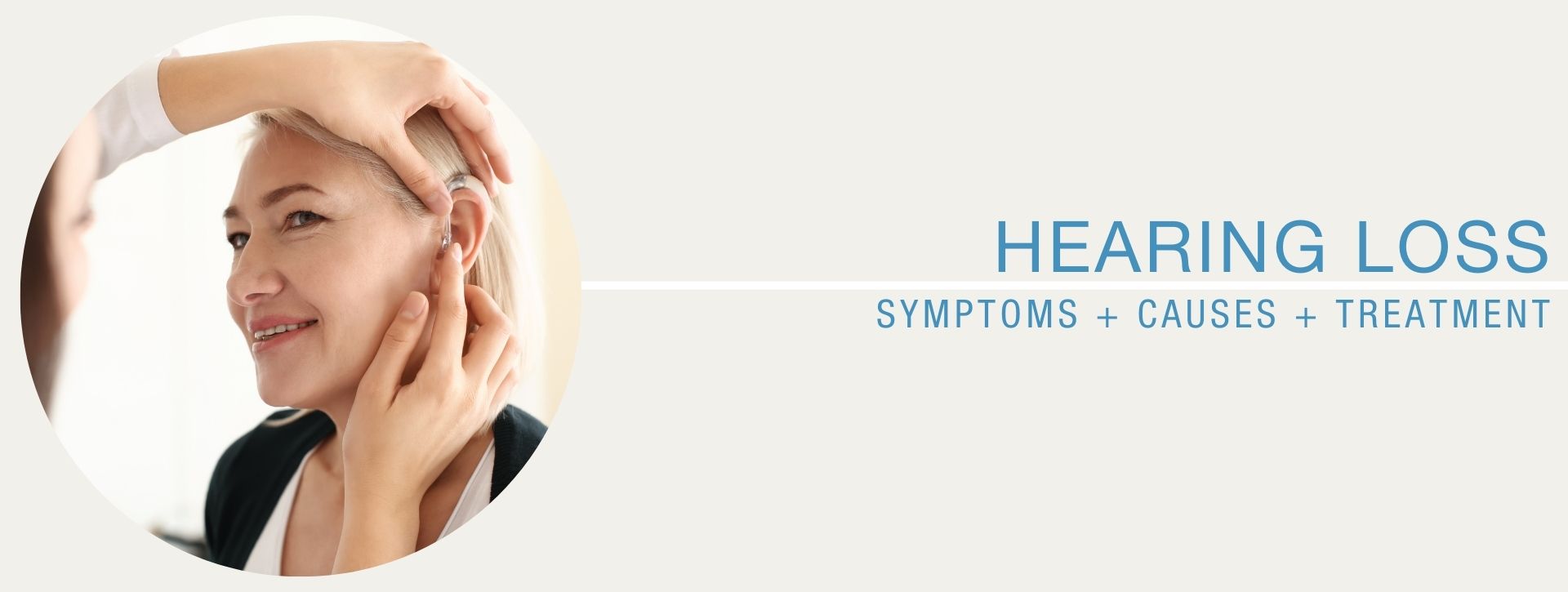

Schedule a Consultation
By submitting this form you agree to be contacted via phone/text/email.
HEARING AIDS | HEARING LOSS TREATMENT | AUDIOLOGIST
Hearing loss significantly affects a person’s quality of living. Fortunately, there are many solutions and treatments that alleviate the consequences of losing one’s hearing. Learn more about the available diagnostics and treatments for hearing loss. Specifically, discover how hearing aids restore a person’s hearing so they can continue living an engaged, active life.
THE ANATOMY OF HEARING LOSS
Hearing loss is a common problem in older individuals, usually beginning in their 60s and 70s. However, children and younger adults may experience hearing loss. When someone’s hearing is compromised, they often struggle to hear in loud spaces. Often it seems as if the person can listen to the sounds but can’t quite make out the words.
There are two main types of hearing loss: conductive hearing loss and sensorineural hearing loss.
Conductive hearing loss is caused when sound is unable to get to the inner ear. An obstruction in the ear normally causes this. For example, wax in your ear canal or fluid buildup behind your eardrum may cause conductive hearing loss.
Sensorineural hearing loss results when the inner ear cannot properly sense the sounds coming from the outside world. This results from damage to “hair cells,” the small sensory cells within the inner ear. Sensorineural hearing loss is often age-related or caused by exposure to loud noises. This type of hearing loss tends to worsen over time.
Sometimes the cause of hearing loss can be fixed and hearing restored. Other times, a hearing aid is the right solution.
DIAGNOSING HEARING LOSS
Your audiologist may perform a hearing test called an audiogram. An audiogram uses pure-tone hearing testing to measure the quietest sound a person can detect at different frequencies (pitches.) This test enables your audiologist to determine the type of hearing loss you are suffering from and your degree of hearing loss.
TREATING HEARING LOSS WITH HEARING AIDS
Hearing aids are the gold standard for treating sensorineural hearing loss. Hearing aids are small electronic devices worn in or behind the ear. Hearing aids amplify sound vibrations enabling the wearer to better listen, communicate, and participate in their environment.
Hearing aids have three main parts. These include the microphone, amplifier, and speaker. The microphone receives outside sounds. The sound waves are converted into electrical signals and sent to the amplifier. The amplifier magnifies the sound, making it louder. The sound is then sent to the ear through the speaker.
DIFFERENT TYPES OF HEARING AIDS
There are different types of hearing aids. They vary in price, size, placement, and unique features.
DIFFERENT ELECTRONICS: First, there are two types of electronics used in hearing aids: analog hearing aids and digital hearing aids.
An analog hearing aid converts sound vibrations into electrical signals that are then amplified. Analog hearing aids are programmable. Your audiologist will calibrate your analog hearing aid settings to conform to the specifics of your hearing loss. Analog hearing aids usually cost less than digital hearing aids.
A digital hearing aid converts sound vibrations into numerical codes before amplifying the sound. These codes include data on the sound’s loudness and frequency. This allows your audiologist to program the digital hearing aid to amplify some pitches more than others. Digital hearing aids provide more customization than analog hearing aids.
DIFFERENT STYLES: Hearing aids also come in different styles. They vary in the size and shape of the hearing aid and the hearing aid’s placement.
Behind-the-ear (BTE) hearing aids are utilized by individuals of all ages with mild to severe hearing loss. Traditional BTE hearing aids involve a plastic casing that contains the electronics of the hearing aid. The casing is worn behind the ear. The outer casing connects to a plastic earmold that fits inside the inner ear.
An open-fit hearing aid is a smaller type of the behind-the-ear style of hearing aids. The open-fit hearing aid fits entirely behind the ear, sending sound waves through a narrow tube inserted into the ear canal.
In-the-ear (ITE) hearing aids are ideal for older patients with mild to severe hearing loss. They consist of a hard plastic casing that fits inside the outer ear. ITE hearing aids can include additional features, such as a telecoil. This small magnetic coil permits sound through the hearing aid’s circuitry rather than the microphone. This allows the wearer to better understand sounds through the telephone or sound systems.
Canal hearing aids help individuals with mild to moderate hearing loss. Canal aids fit into the ear canal. Canal aids are small and often discrete, making them hard to see. Their small size comes with both advantages and disadvantages.
WHICH HEARING AID IS RIGHT FOR YOU?
Your audiologist will help you determine which hearing aid is right for you. Decisions are based according to the specifics of your hearing loss, as well as your lifestyle, goals, and budget.
AUDIOLOGIST NEAR ME
If you are concerned about your hearing, call the Ear, Nose, & Throat Center in Stamford, CT today to schedule an appointment. We have a team of dedicated ENT doctors and audiologists who are experts in hearing solutions and hearing aids. Our audiologists offer a full line of top-quality hearing aids from a variety of different manufacturers. Reach out online by completing the form below or call 203-353-0000 to schedule your appointment.
Schedule a Consultation
By submitting this form you agree to be contacted via phone/text/email.
Schedule a Consultation
By submitting this form you agree to be contacted via phone/text/email.




